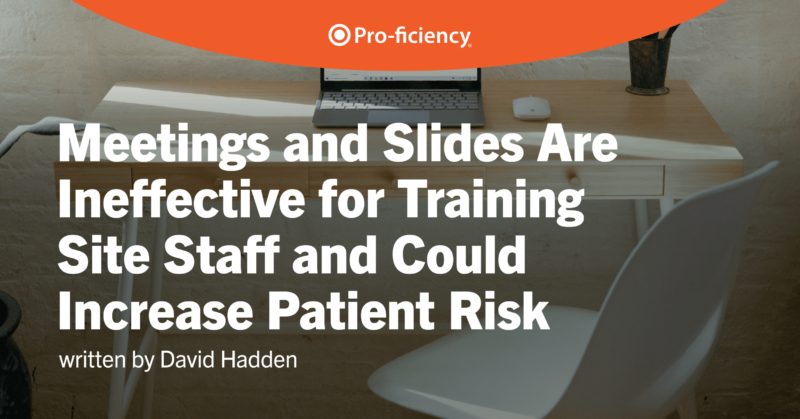Is Your Trial Training Compliant With FDA and ICH Regulations?
Are you outsourcing any of your protocol, GCP, or Safety training for investigations and site staff?
Training is important for study quality and patient safety. There is no point in investing tens of millions in a clinical trial and not training the sites appropriately.
Many training outsourcing opportunities exist from CROs and training companies to assist you with training your site staff which are based on old and ineffective technology, and are not validated according to FDA and ICH standards.
Training can impact people’s decisions which can impact subjects in turn. In if you are providing training in support of a GxP activity, you must provide evidence that the person creating the content was qualified or provide evidence that the person noted actually completed the training. This can only be verified through an audit trail of a validated system.
The Pro-ficiency online platform and the simulation-based training content housed there is fully validated and audit-ready according to CFR 21 parts 820 and 11 and applicable sections of ICH GCP E6(R2).
- Use the best training for your sites
- Play it safe by using validated systems and content that meets CFR 21 820/11 and ICH E6(R2).
- Protect patient safety by validating site training content before it is delivered
Predictive Analytics (real-time access)
The Pro-ficiency dashboard shows investigator performance in the training simulations across dozens of critical protocol and GCP metrics (the vertical columns). A blue checkmark indicates that a specific decision was made appropriately. If the learner makes a mistake, then a brief video-based corrective action is launched and they get a yellow icon. If the learner makes that mistake again, they get red icon. Lots of yellow icons indicate that, while knowledge gaps were identified, they were also easily corrected. Lots of red icons means those investigators are either not trying or they are having real problems understanding the protocol.

Based on the performance of the 2 sites above, which one would you trust more with your protocol and expect better performance from?

Dave Hadden is an entrepreneur and technology innovator, founding Pro-ficiency and pioneering the fields of A.I.-based medical decision-support, Training Analytics, and Virtual Patient Simulation (VPS). Dave has focused his passion for technological innovation and learning systems in the field of clinical trials, helping sponsors make their studies more accurate and efficient through finding the right technology mix such as virtualization, performance management and applied behavioral sciences to produce the most effective, lasting, and engaging results for clinical trials.











